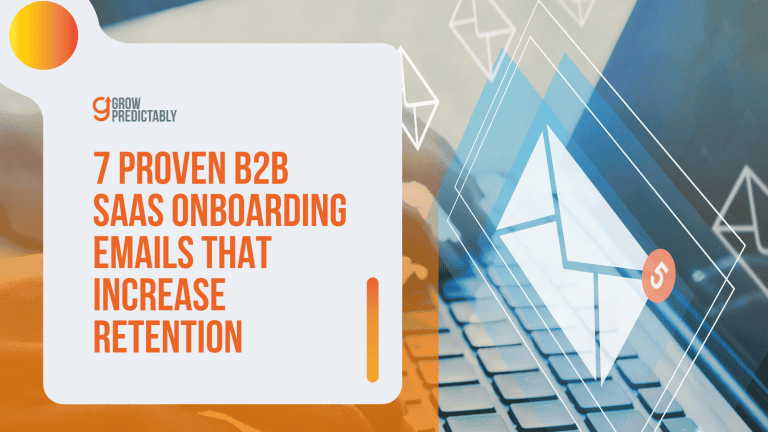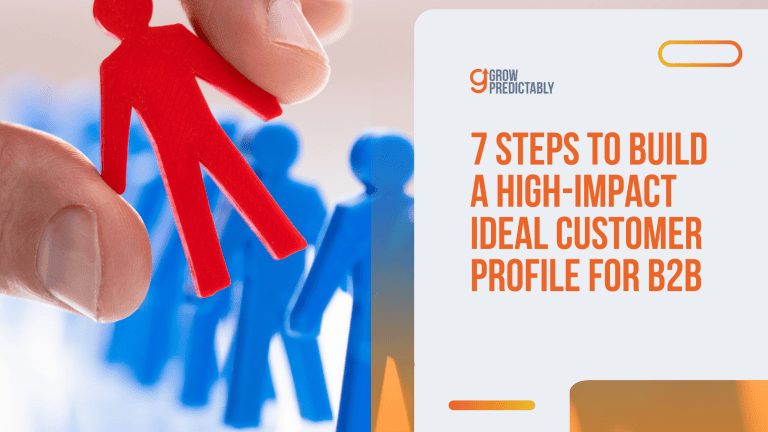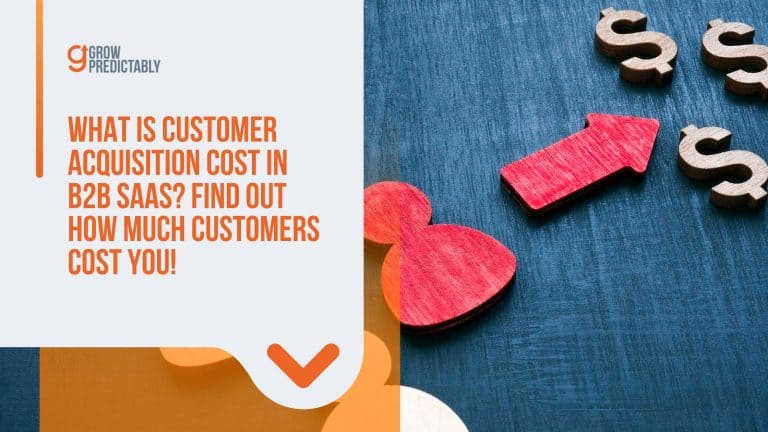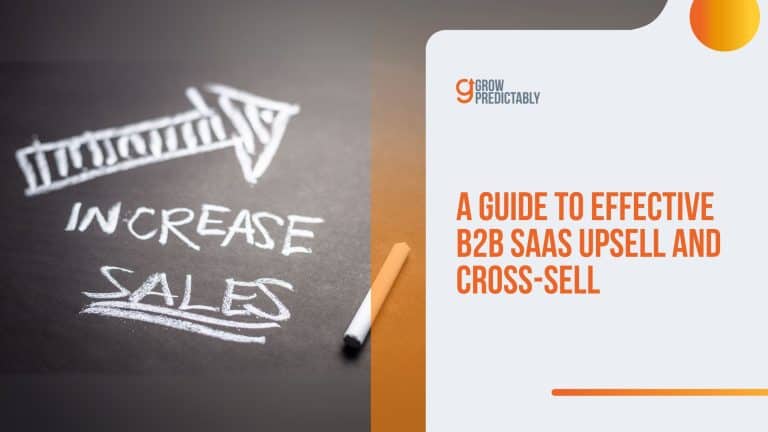B2B SaaS CMO: What to Expect and What to Avoid
Trying to navigate B2B SaaS marketing without expert guidance may lead to costly missteps and missed opportunities.
Fortunately, there are executives assigned to ensure these don’t happen with the use of their strategic vision, leadership, and data-driven insights.
Who are they? In business, these are your chief marketing officers.
Their main goal? Lead the business to marketing success to create a loyal customer base that keeps coming back for more.
Imagine fostering a marketing approach deeply tied to business outcomes, where every campaign pushes the needle forward.
With the right B2B SaaS CMO, you can put systems in place to make this happen.
Let’s dive into the roles and responsibilities of a CMO, as well as what it takes to ensure effective and dynamic marketing leadership.
CMO (Chief Marketing Officer) – What to expect?
A Chief Marketing Officer (CMO) is essential in shaping how a company is perceived.
In a B2B SaaS business, the CMO’s role is key to bridging the company’s story with its audience, clearly showcasing the company’s value.
Beyond storytelling, they drive growth by crafting strategies for customer acquisition and retention.
Think of the CMO as an orchestra conductor, harmonizing elements from product positioning to demand generation and lead generation into a cohesive strategy that attracts and retains clients.
This balance of customer needs and business goals is crucial for scalable growth through an effective digital marketing strategy.
Ultimately, the CMO aligns marketing efforts with company objectives, enhancing the overall impact of marketing on company strategy.
Key Responsibilities of a B2B SaaS Chief Marketing Officer

Drawing insights from experts and online forums, we can outline the core responsibilities that a B2B SaaS CMO must manage effectively:
- Strategic Planning: Developing comprehensive marketing strategies that align with business goals and the competitive landscape, as highlighted by B2B SaaS experts on platforms like Kalungi.
- Marketing Team Leadership: Building and mentoring a high-performing marketing team that together brings the vision to life through creative, data-driven campaigns (source: Foundation Inc).
- Brand Management: Ensuring that all marketing communications consistently reinforce the brand’s identity and values. This aspect involves close work with other departments to maintain brand uniformity across various platforms.
- Customer Acquisition and Retention: Designing strategies not just to attract, but also to retain customers. This approach involves feedback loops from sales and customer service to refine offerings (discussed in the SaaS Resources Blog).
- Data-Driven Decision Making: Leveraging analytics and market research to make informed decisions on marketing initiatives, ensuring every move is backed by data. This responsibility is echoed by industry leaders in forums such as Forum Ventures.
- Cross-Departmental Collaboration: Coordinating with sales, product development, and customer support to ensure marketing strategies are well-integrated with other business processes. This importance is often discussed in professional development communities like Pavilion.
- Resource and Budget Management: Efficiently managing marketing budgets and resources to maximize ROI. This responsibility ensures that every dollar spent contributes to the company’s growth objectives.
This well-rounded approach, as supported by seasoned CMOs and marketing leaders in expert forums, encapsulates the multifaceted nature of a CMO’s role in the B2B SaaS space.
Find Out If It’s High Time to Hire a CMO
The ideal business size for working with a Chief Marketing Officer (CMO) can vary depending on several factors, including budget, marketing complexity, and growth objectives.
Here’s a breakdown of how CMOs can benefit different business sizes:
➡️ Small-Sized Business
Small businesses often face challenges in managing comprehensive marketing strategies due to limited resources and budget constraints.
However, a CMO can be beneficial in helping small businesses focus on their core competencies while outsourcing marketing responsibilities.
An outsourced or fractional chief marketing officer is particularly suitable for small businesses as it provides access to high-level marketing expertise and facilitates demand generation without the commitment of a full-time salary.
➡️ Medium-Sized Business
Medium-sized businesses are often on the cusp of significant growth and require strategic marketing leadership and a robust go to market strategy to navigate this phase effectively.
A fractional CMO is particularly attractive to mid-size companies as it offers senior leadership and expertise at a fraction of the cost of a full-time hire, allowing for efficient expansion of marketing capacity and financial flexibility.
➡️ Large Enterprise
Large enterprises typically have the budget and complexity to justify a full-time CMO.
In these organizations, the CMO plays a crucial role in driving business growth, overseeing complex marketing strategies, and contributing to strategic planning and budgeting.
Large enterprises often require continuous oversight and management of comprehensive marketing strategies, making a full-time CMO more suitable.
In summary, while small businesses may benefit from outsourced or fractional CMOs due to budget constraints, medium-sized businesses often find fractional CMOs ideal for strategic growth.
Large enterprises, with their complex marketing needs and budgets, typically require full-time CMOs.
| Business Size | Ideal CMO Arrangement | Benefits |
|---|---|---|
| Small | Outsourced/Fractional | Cost-effective, focused expertise |
| Medium | Fractional | Cost-effective, strategic growth |
| Large | Full-time | Comprehensive strategy management |
What is a Fractional CMO?
A fractional Chief Marketing Officer (CMO) is a part-time executive who provides high-level marketing expertise to businesses without the need for a full-time commitment.
The main edge of a fractional CMO lies in flexibility and cost-effectiveness.
Companies gain access to seasoned marketing leaders and strategic insights tailored to specific needs and budgets.
This approach is ideal for businesses looking to scale their marketing efforts efficiently without the expense of a full-time chief marketing officer.
Having a Marketing Leader Benefits Your Marketing Team
Having a Chief Marketing Officer (CMO) or a fractional CMO can elevate your marketing team’s impact.
Here’s how:
- Strategic Vision: CMOs bring a clear, strategic vision, aligning marketing efforts with overall business goals. Their expertise ensures that marketing strategies are not only innovative and effective but are also aligned with the goals of the executive leadership team.
- Leadership and Development: They foster a culture of growth and learning within the team, providing guidance and mentorship from established marketing leaders to enhance performance and skills.
- Resource Optimization: Expert CMOs make the most of your marketing budget, focusing on campaigns that maximize ROI and drive measurable results.
- Data-Driven Insights: With their strong analytical skills, CMOs make informed decisions that leverage data to refine strategies and outperform the competition.
- Brand Consistency: They ensure that your brand message remains consistent and compelling across all channels, strengthening brand identity.
Having a CMO/fractional chief marketing officer transforms marketing challenges into growth opportunities.
- “The role of the CMO is evolving from being the voice of the brand to being the voice of the customer within the company.” — Deborah Wahl, CMO of General Motors
- “CEOs who place marketing at the core of their growth strategy are twice as likely to have greater than 5 percent annual growth compared with their peers.” — McKinsey Study
- “Marketing has to have a seat at the business strategy table or it will create risk for the company.” — Jennifer Leggio
5 B2B Marketing Mistakes that Good CMOs Avoid
But what if you already have a CMO running the marketing for your B2B business, or what if you’re the CMO and you want to make sure that the company’s marketing starts on the right foot?
There are practices in marketing that help separate the bad CMOs from the good.
Let’s go over the most common practices that the right CMOs prevent from happening.
1. Not Aligning Marketing Strategy with Business Goals
Imagine this scenario: A SaaS company burns through $2 million in marketing spend, yet its customer base barely grows. Why?
Their marketing efforts weren’t tied to real business outcomes, a costly mistake for any SaaS company that I’ve seen too many times.
Let’s explore how to fix this.
We’ll use a Growth Scorecard – a tool that transformed how I track marketing success.
Why Alignment Matters
When marketing doesn’t sync with business goals, things get messy fast.
Scattered efforts, wasted budgets, and frustrated teams are common symptoms.
I learned this firsthand by tracking web traffic that looked great on paper but didn’t drive sales.
The Growth Scorecard Solution
Here’s where the Growth Scorecard shines. It breaks down your customer journey into clear stages:
- Aware: Track new website visitors and brand mentions
- Engage: Monitor content engagement and time on site
- Subscribe: Count email signups and resource downloads
- Convert: Measure trial starts and first purchases
- Excite: Track product usage and satisfaction scores
- Ascend: Monitor upsells and expansion revenue
- Advocate: Count referrals and testimonials
- Promote: Track social shares and case studies
For each stage, you’ll use a simple red-yellow-green system:
- Red = Way off target
- Yellow = Getting close
- Green = Hitting goals
Start small. Pick 2-3 key metrics per stage. Update weekly and use Google Sheets because it’s simple and shareable.
Remember – this isn’t just about tracking numbers. It’s about spotting gaps and fixing them fast.
When I notice red metrics in the “Convert” stage, for example, I know to focus on improving our sales process.
Cross-Team Buy-In
Marketing can’t work in isolation. Get your sales, product, and customer success teams involved.
Share the scorecard in weekly meetings and make decisions together.
One quick win? Set up a monthly “alignment check” where teams share their goals and challenges.
This simple step has helped me prevent costly miscommunications.
The Cost of Inaction
Let me be straight – not aligning marketing with business goals is expensive.
One of my clients lost $300,000 on campaigns that looked flashy but didn’t drive revenue. Don’t make that mistake.
Remember, alignment isn’t a one-time fix – it’s an ongoing journey.
But with a Growth Scorecard as your guide, you’ll spend less time guessing and more time growing.
2. Ignoring the Power of AI and Automation
Remember our talk about aligning marketing with business goals?
Now let’s explore how AI helps a SaaS company supercharge those efforts.
You’re probably wondering, “What’s the real cost of skipping AI automation?”
Let’s dig in.

The price of manual marketing hits hard.
Teams drowning in spreadsheets miss golden opportunities while competitors zoom ahead with smart automation.
I’ve seen this firsthand.
Working with a SaaS client, we turned a 3-day content creation process into a 4-hour workflow using AI tools.
The secret?
We mapped every manual task to automation opportunities using our Growth Scorecard framework:
Awareness Stage 🎯
- AI-powered content creation
- Automated social media scheduling
- Smart ad optimization
Engagement Stage 💬
- AI chatbots for 24/7 response
- Automated email sequences
- Smart lead scoring
Conversion Stage 💰
- Predictive analytics for sales readiness
- Automated follow-up systems
- AI-driven personalization
But watch out – throwing AI at everything isn’t the answer.
I learned this when rushing to automate our team’s customer service.
The AI responses felt robotic, and complaints shot up.
We stepped back and created a hybrid approach: AI handles routine questions while humans tackle complex issues.
Ready to jump into AI but not sure where to start?
Here’s your quick-win checklist:
- Track time spent on repetitive tasks for one week
- Pick the top three time-drains
- Test one AI tool for each task
- Measure the time saved and impact on results
Speaking of results, we’ll explore how Marketo transformed its marketing operations later.
But first, here’s a warning: Companies that wait too long to adopt AI may see customer acquisition costs jumping higher than early adopters.
Want to avoid that fate?
Start small, but start now.
Test AI tools for one marketing task this week.
Track your results using the red-yellow-green system in your Growth Scorecard.
Green means the AI performs better than manual work, yellow means it needs tweaking, and red signals it’s time to try a different approach.
Now that we’ve uncovered AI’s potential in streamlining your marketing, let’s tackle another crucial piece of the puzzle – why investing in customer success could make or break your growth plans.
3. Not Building a Strong Customer Success Program
You could be spending months perfecting your marketing, bringing in great leads, and closing deals, and all of a sudden, customers start dropping off faster than you can bring new ones in.
It’s like filling a bucket with holes.
Here’s a simple fact: Cutting churn by just 5% can boost your profits by 25%. (Source)
That’s not just numbers talking – it’s real money walking out the door when customer success takes a backseat.
Let’s explain why this matters and what you can do about it.
The Hidden Cost of Weak Customer Success
When companies skimp on customer success, they’re setting themselves up for trouble.
I track this using a simple red-yellow-green system in my Growth Scorecard:
- 🔴 Red: Rising churn rates, dropping engagement
- 🟡 Yellow: Stable but not growing customer satisfaction
- 🟢 Green: Strong retention, growing customer lifetime value
From watching hundreds of SaaS companies grow (and sometimes struggle), I’ve learned a valuable lesson about the critical role of a marketing strategy.
Customer success isn’t just a nice-to-have – it’s your growth engine.
Building Your Customer Success Foundation
Here’s what works, based on real wins I’ve seen with an effective go to market strategy.:
Create Your Success Team
- Start with one dedicated person focused purely on customer wins
- Set clear goals tied to retention and satisfaction
- Give them direct access to the product and marketing teams
Set Up Your Feedback Loop
- Run quarterly check-ins with key accounts
- Track usage patterns to spot risks early
- Share insights with marketing to improve messaging
Pick Your Tools Wisely
- Use simple tools at first (even spreadsheets work)
- Graduate to platforms like Salesforce Customer Success Cloud as you grow
- Focus on tracking what matters: usage, satisfaction, and retention
I remember working with a struggling SaaS company that was bleeding customers.
Their product was solid, but they’d focused all their energy on sales. We switched gears, built a small but mighty customer success team, and within six months, their churn dropped by 40%.
The key? They started treating customer success as a profit center, not a cost center.
Warning Signs You’re Falling Behind
Watch for these red flags:
- Customers ghosting your check-ins
- Rising support tickets about basic features
- Dropping renewal rates
- Silence (sometimes the scariest signal)
Start small but start now:
- Map your current customer journey
- Pick one metric to improve (I suggest starting with churn)
- Talk to five customers this week
- Document what you learn
- Make one improvement based on feedback
Without data-driven insights guiding these efforts, even the best customer success plans can fall flat.
Remember this: Every customer who leaves takes their lifetime value with them. But every customer who stays and succeeds becomes your best marketing asset.
Your customer success program isn’t just about keeping customers happy – it’s about enhancing demand generation and building a sustainable growth engine that powers everything else in your business.
4. Failing to Leverage Data-Driven Decision-Making
Imagine you’re spending tens of thousands monthly on marketing, but can’t pinpoint which campaigns drive real results.
Sounds scary, right? That’s what happens when gut feelings trump data.
Drawing from my knowledge of Google Analytics UTMs, tracking website leads directly shows what drives sales and spots problems early.
The Growth Scorecard Solution
Instead of drowning in data, use a simple red-yellow-green tracking system:
- 🔴 Red: Metrics falling below targets
- 🟡 Yellow: Metrics approaching goals
- 🟢 Green: Metrics exceeding expectations
Track these weekly across your customer journey:
- Awareness: Website traffic, social reach
- Engagement: Time on site, bounce rates
- Conversion: Lead-to-customer rate
- Retention: Customer lifetime value
From my experience with weekly growth scorecards, this visual system makes it easy to spot trends and take action fast.
Start here:
- Set up basic tracking
- Install Google Analytics 4
- Add UTM codes to all campaign links
- Track conversion events
- Create weekly check-ins
- Review key metrics
- Identify red flags
- Adjust campaigns based on data
- Build team habits
- Share insights in simple terms
- Celebrate data-driven wins
- Train teams on basic analytics
Using my experience with A/B testing, I’ve seen small changes driven by data boost leads without big costs.
The Netflix Example
Netflix saves $1 billion yearly using data to predict viewer preferences.
While your SaaS company might not be Netflix, you can apply their approach:
- Test different content types
- Track engagement patterns
- Personalize based on user behavior
- Make decisions based on results, not assumptions
Remember: Data doesn’t replace creativity – it enhances it. Think of data as your compass, helping navigate toward what works while steering clear of expensive mistakes.
From tracking client campaigns, I’ve learned that data reveals surprising insights about what customers really want versus what we think they want.
Ready to dive deeper into brand differentiation?
Let’s explore how standing out in your market through effective demand generation builds on these data-driven foundations.
5. Neglecting Brand Differentiation and Thought Leadership
Imagine walking into a room full of identical products. How would you choose?
This is what happens when B2B SaaS companies or their marketing teams fail to build distinct brands.
Strong brands don’t just stand out – they command premium pricing, and their marketing team sparks genuine customer connections.
The Consequences of Skipping Brand Building
Here’s what happens when you skip brand building:
- Your sales team fights constant price wars
- Marketing messages blend into background noise
- Customer loyalty stays surface-deep
- Competitors can easily copy your features
HubSpot’s Success
HubSpot shows us a better way.
They didn’t just create content – they owned the “inbound marketing” conversation.
By teaching others their methodology, they built trust that turned into $1.3 billion in revenue last year.
Want to stand out?

Here are the core elements of branding that you need to know:
- Identity – Your brand identity/visual identity includes your company’s name, logo, colors, and designs. These are the visual pieces that make your brand recognizable. Think of them as the face of your company.
- Voice – Your brand voice is how you talk to your customers. Are you friendly? Professional? Fun? Keeping a consistent tone helps people know what to expect from you.
- Promise – This is what you guarantee to deliver to your customers. It could be great customer service or dependable software. Your promise sets you apart from other companies.
- Values – These are the principles that guide your company. They show what you believe in and stand for. Sharing your values helps build trust with your users.
- Experience – This is about how users feel when they use your software. Is it easy to use? Does it solve their problems? A good experience keeps customers coming back.
Why are these elements important? Because they help you create a strong brand that stands out and builds trust with your users.
When people recognize and trust your brand, they are more likely to choose your software over others.
FAQs
Align or Fall Behind
From multi-million-dollar marketing failures to SaaS success through strategic alignment, this article revealed what separates companies that burn cash from those that build empires.
The difference? Clarity. Accountability. Execution.
It’s time to take ownership of your growth story.
When your team, tools, and tactics align with real business outcomes—you don’t spin wheels, you gain traction.
📌 Start now: Audit your current scorecard, meet with cross-functional teams, and identify one blind spot to fix using the red-yellow-green system.
Here’s a thought to leave you with: How much faster could you grow if every part of your business spoke the same language of success?
In a world of noise, alignment gives you clarity. And clarity builds momentum. Momentum builds market leaders.








